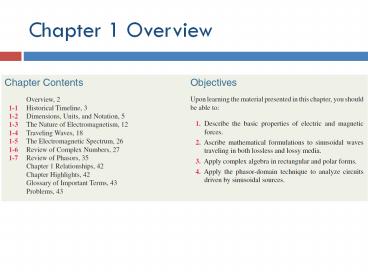Chapter 1 Overview PowerPoint PPT Presentation
Title: Chapter 1 Overview
1
Chapter 1 Overview
2
Examples of EM Applications
3
Dimensions and Units
4
(No Transcript)
5
Fundamental Forces of Nature
6
Gravitational Force
Force exerted on mass 2 by mass 1
Gravitational field induced by mass 1
7
Charge Electrical property of particles
Units coulomb
One coulomb amount of charge accumulated in one
second by a current of one ampere.
1 coulomb represents the charge on 6.241 x 1018
electrons
The coulomb is named for a French physicist,
Charles-Augustin de Coulomb (1736-1806), who was
the first to measure accurately the forces
exerted between electric charges.
Charge of an electron
e 1.602 x 10-19 C
Charge conservation
Cannot create or destroy charge, only transfer
8
Electrical Force
Force exerted on charge 2 by charge 1
9
Electric Field In Free Space
Permittivity of free space
10
Electric Field Inside Dielectric Medium
Polarization of atoms changes electric field New
field can be accounted for by changing the
permittivity
Permittivity of the material
Another quantity used in EM is the electric flux
density D
11
Magnetic Field
Electric charges can be isolated, but magnetic
poles always exist in pairs.
Magnetic field induced by a current in a long wire
Magnetic permeability of free space
Electric and magnetic fields are connected
through the speed of light
12
Static vs. Dynamic
Static conditions charges are stationary or
moving, but if moving, they do so at a constant
velocity.
Under static conditions, electric and magnetic
fields are independent, but under dynamic
conditions, they become coupled.
13
Material Properties
14
Traveling Waves
- Waves carry energy
- Waves have velocity
- Many waves are linear they do not affect the
passage of other waves they can pass right
through them - Transient waves caused by sudden disturbance
- Continuous periodic waves repetitive source
15
Types of Waves
16
Sinusoidal Waves in Lossless Media
y height of water surface x distance
17
Phase velocity
If we select a fixed height y0 and follow its
progress, then
18
Wave Frequency and Period
19
Direction of Wave Travel
Wave travelling in x direction
Wave travelling in ?x direction
x direction if coefficients of t and x have
opposite signs ?x direction if coefficients of
t and x have same sign (both positive or both
negative)
20
Phase Lead Lag
21
Wave Travel in Lossy Media
Attenuation factor
22
Example 1-1 Sound Wave in Water
Given sinusoidal sound wave traveling in the
positive x-direction in water Wave amplitude is
10 N/m2, and p(x, t) was observed to be at its
maximum value at t 0 and x 0.25 m. Also
f1 kHz, up1.5 km/s. Determine
p(x,t) Solution
23
(No Transcript)
24
The EM Spectrum
25
Complex Numbers
We will find it is useful to represent sinusoids
as complex numbers
Rectangular coordinates
Polar coordinates
Relations based on Eulers Identity
26
Relations for Complex Numbers
Learn how to perform these with your
calculator/computer
27
Phasor Domain
1. The phasor-analysis technique transforms
equations from the time domain to the phasor
domain. 2. Integro-differential equations get
converted into linear equations with no
sinusoidal functions. 3. After solving for the
desired variable--such as a particular voltage or
current-- in the phasor domain, conversion back
to the time domain provides the same solution
that would have been obtained had the original
integro-differential equations been solved
entirely in the time domain.
28
Phasor Domain
Phasor counterpart of
29
Time and Phasor Domain
It is much easier to deal with exponentials in
the phasor domain than sinusoidal relations in
the time domain Just need to track
magnitude/phase, knowing that everything is at
frequency w
30
Phasor Relation for Resistors
Current through resistor
Time domain
Time Domain
Frequency Domain
Phasor Domain
31
Phasor Relation for Inductors
Time domain
Phasor Domain
Time Domain
32
Phasor Relation for Capacitors
Time domain
Time Domain
Phasor Domain
33
ac Phasor Analysis General Procedure
34
Example 1-4 RL Circuit
Cont.
35
Example 1-4 RL Circuit cont.
36
(No Transcript)
37
(No Transcript)
38
Summary

